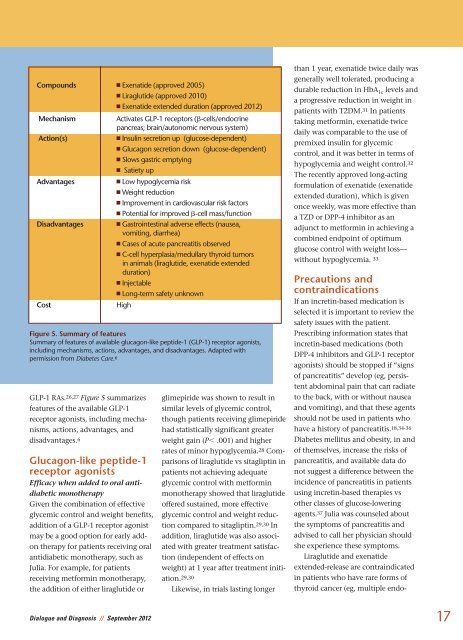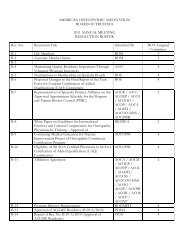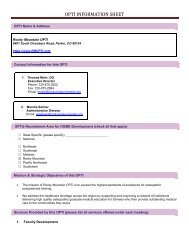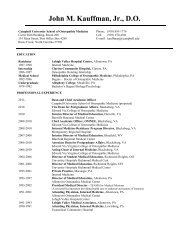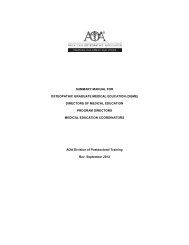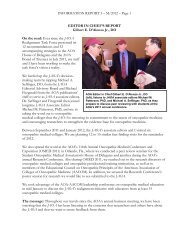Dialogue and Diagnosis - American Osteopathic Association
Dialogue and Diagnosis - American Osteopathic Association
Dialogue and Diagnosis - American Osteopathic Association
Create successful ePaper yourself
Turn your PDF publications into a flip-book with our unique Google optimized e-Paper software.
Compounds Exenatide (approved 2005)<br />
Liraglutide (approved 2010)<br />
Exenatide extended duration (approved 2012)<br />
Mechanism<br />
Action(s)<br />
Advantages<br />
Disadvantages<br />
Cost<br />
GLP-1 RAs. 26,27 Figure 5 summarizes<br />
features of the available GLP-1<br />
receptor agonists, including mechanisms,<br />
actions, advantages, <strong>and</strong><br />
disadvantages. 6<br />
Glucagon-like peptide-1<br />
receptor agonists<br />
Efficacy when added to oral anti -<br />
diabetic monotherapy<br />
Given the combination of effective<br />
glycemic control <strong>and</strong> weight benefits,<br />
addition of a GLP-1 receptor agonist<br />
may be a good option for early addon<br />
therapy for patients receiving oral<br />
antidiabetic monotherapy, such as<br />
Julia. For example, for patients<br />
receiving metformin monotherapy,<br />
the addition of either liraglutide or<br />
Activates GLP-1 receptors (-cells/endocrine<br />
pancreas; brain/autonomic nervous system)<br />
Insulin secretion up (glucose-dependent)<br />
Glucagon secretion down (glucose-dependent)<br />
Slows gastric emptying<br />
Satiety up<br />
Low hypoglycemia risk<br />
Weight reduction<br />
Improvement in cardiovascular risk factors<br />
Potential for improved -cell mass/function<br />
Gastrointestinal adverse effects (nausea,<br />
vomiting, diarrhea)<br />
Cases of acute pancreatitis observed<br />
C-cell hyperplasia/medullary thyroid tumors<br />
in animals (liraglutide, exenatide extended<br />
duration)<br />
Injectable<br />
Long-term safety unknown<br />
High<br />
Figure 5. Summary of features<br />
Summary of features of available glucagon-like peptide-1 (GLP-1) receptor agonists,<br />
including mechanisms, actions, advantages, <strong>and</strong> disadvantages. Adapted with<br />
permission from Diabetes Care. 6<br />
glimepiride was shown to result in<br />
similar levels of glycemic control,<br />
though patients receiving glimepiride<br />
had statistically significant greater<br />
weight gain (P .001) <strong>and</strong> higher<br />
rates of minor hypoglycemia. 28 Comparisons<br />
of liraglutide vs sitagliptin in<br />
patients not achieving adequate<br />
glycemic control with metformin<br />
monotherapy showed that liraglutide<br />
offered sustained, more effective<br />
glycemic control <strong>and</strong> weight reduc -<br />
tion compared to sitagliptin. 29,30 In<br />
addition, liraglutide was also associated<br />
with greater treatment satisfaction<br />
(independent of effects on<br />
weight) at 1 year after treatment initiation.<br />
29,30<br />
Likewise, in trials lasting longer<br />
than 1 year, exenatide twice daily was<br />
generally well tolerated, producing a<br />
durable reduction in HbA 1c levels <strong>and</strong><br />
a progressive reduction in weight in<br />
patients with T2DM. 31 In patients<br />
taking metformin, exenatide twice<br />
daily was comparable to the use of<br />
premixed insulin for glycemic<br />
control, <strong>and</strong> it was better in terms of<br />
hypoglycemia <strong>and</strong> weight control. 32<br />
The recently approved long-acting<br />
formulation of exenatide (exenatide<br />
extended duration), which is given<br />
once weekly, was more effective than<br />
a TZD or DPP-4 inhibitor as an<br />
adjunct to metformin in achieving a<br />
combined endpoint of optimum<br />
glucose control with weight loss—<br />
without hypoglycemia. 33<br />
Precautions <strong>and</strong><br />
contraindications<br />
If an incretin-based medication is<br />
selected it is important to review the<br />
safety issues with the patient.<br />
Prescribing information states that<br />
incretin-based medications (both<br />
DPP-4 inhibitors <strong>and</strong> GLP-1 receptor<br />
agonists) should be stopped if “signs<br />
of pancreatitis” develop (eg, persis -<br />
tent abdominal pain that can radiate<br />
to the back, with or without nausea<br />
<strong>and</strong> vomiting), <strong>and</strong> that these agents<br />
should not be used in patients who<br />
have a history of pancreatitis. 18,34-36<br />
Diabetes mellitus <strong>and</strong> obesity, in <strong>and</strong><br />
of themselves, increase the risks of<br />
pancreatitis, <strong>and</strong> available data do<br />
not suggest a difference between the<br />
incidence of pancreatitis in patients<br />
using incretin-based therapies vs<br />
other classes of glucose-lowering<br />
agents. 37 Julia was counseled about<br />
the symptoms of pancreatitis <strong>and</strong><br />
advised to call her physician should<br />
she experience these symptoms.<br />
Liraglutide <strong>and</strong> exenatide<br />
extended-release are contraindicated<br />
in patients who have rare forms of<br />
thyroid cancer (eg, multiple endo -<br />
<strong>Dialogue</strong> <strong>and</strong> <strong>Diagnosis</strong> // September 2012<br />
17


